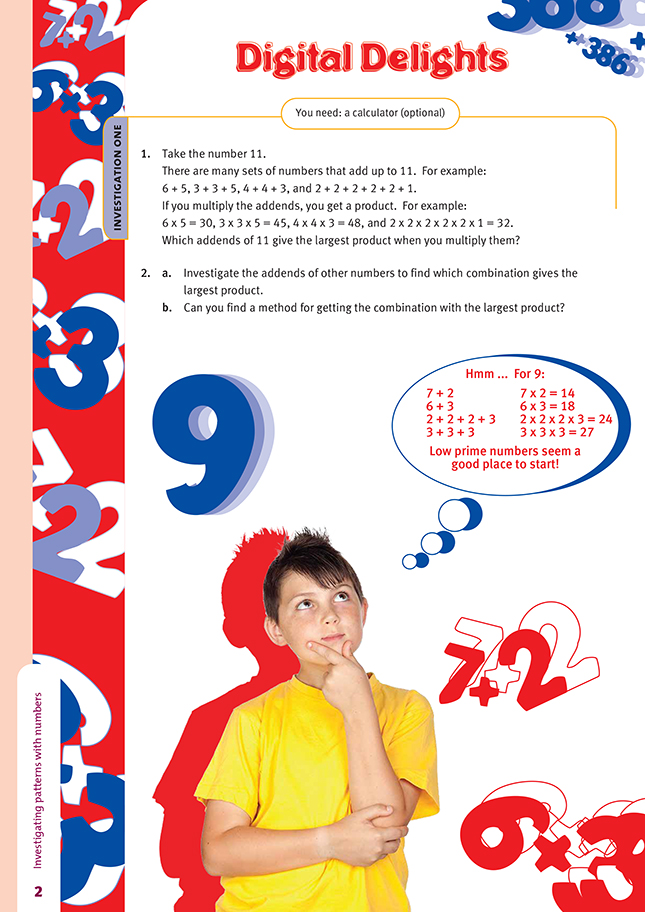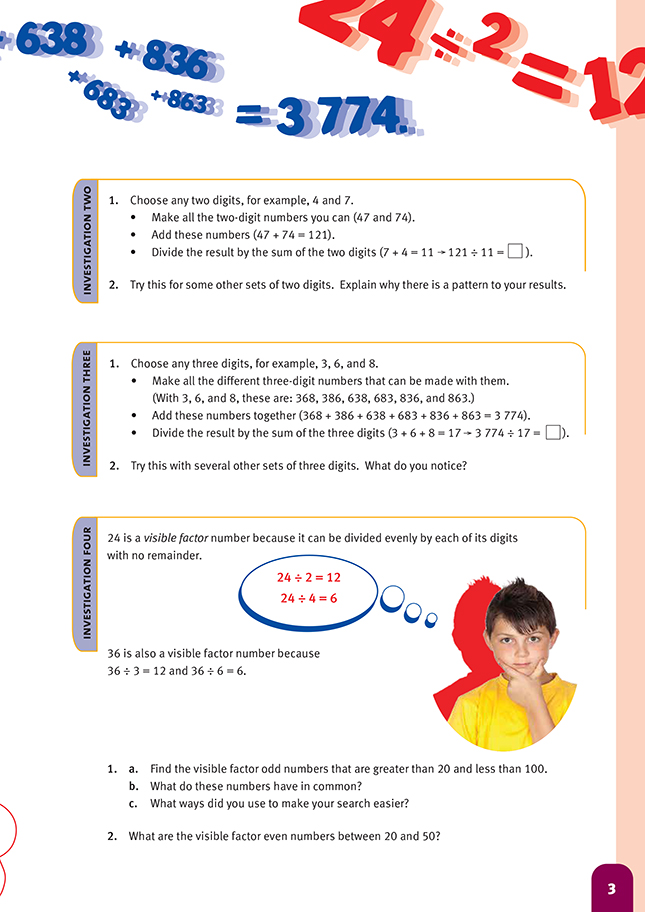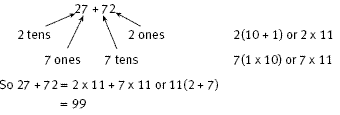This is a level 4 algebra activity from the Figure It Out series.
A PDF of the student activity is included.
Click on the image to enlarge it. Click again to close. Download PDF (249 KB)
investigate patterns involving multiplication and division
FIO, Level 4+, Number, Book Six, Digital Delights, pages 2-3
A calculator (optional)
Investigation One
This investigation is structured so that the students explore the mathematical patterns in several examples and are then invited to see if they can find some generalisation that would apply to all examples. You may like to discuss the hint given in the speech bubble. This will help them with their answer to question 2b. Using combinations of the lowest prime numbers that are addends of any number is the best method for
trying to achieve the greatest product. Take the number 14, for example. The addends 3 + 3 + 3 + 3 + 2, when multiplied, give 162, which is greater than any other combination.
Investigation Two
This investigation is similar to Investigation One in that exploration of the patterns in individual examples can lead to a more generalised explanation. One way of explaining the pattern is provided in the Answers. You could also explain it like this:
No matter which two digits are chosen, there will always be 11 lots of the sum of the two digits. It therefore follows that dividing the total of the expression by the sum of the two digits will always give a result of 11.
Investigation Three
The students should be able to build on the pattern in Investigation Two to find the pattern in this investigation.
With any three digits, for example, 7, 4, and 1, the students can make six different three-digit numbers. Each digit will appear twice in the hundreds column, twice in the tens column, and twice in the ones column. One way of showing this is provided in the Answers. Another way of adding these together is:
(7 x 100) + (7 x 100) + (7 x 10) + (7 x 10) + (7 x 1) + (7 x 1), and
(4 x 100) + (4 x 100) + (4 x 10) + (4 x 10) + (4 x 1) + (4 x 1), and
(1 x 100) + (1 x 100) + (1 x 10) + (1 x 10) + (1 x 1) + (1 x 1).
This can be shortened, again using the distributive property, to (7 x 200) + (7 x 20) + (7 x 2), and (4 x 200) + (4 x 20) + (4 x 2), and (1 x 200) + (1 x 20) + (1 x 2). Collecting all this together and using the commutative property to change the order of the terms gives 200 x (7 + 4 + 1) + 20 x (7 + 4 + 1) + 2 x (7 + 4 + 1) = 222 x (7 + 4 + 1).
This can also be shown as:
741 + 714 + 471 + 417 + 174 + 147
= 7(100 + 100 + 10 + 1 + 10 + 1)
+ 4( 10 + 1 + 100 + 100 + 1 + 10)
+ 1( 1 + 10 + 1 + 10 + 100 + 100)
= 7(222) + 4(222) + 1(222)
= (7 + 4 + 1)(222)
Thus, it can be seen that the result will be equal to 222 times the sum of the three digits and that dividing the result by the sum of the three digits will always yield 222.
Investigation Four
This investigation introduces the idea of “visible factor” numbers, that is, numbers that can be divided evenly by each of the digits in the number. For question 1a, the students may realise, after they have found 33 and 55, that the four possible visible factor odd numbers that are greater than 20 and less than 100 are multiples of 11. They may need to confirm this by trialling and eliminating the other odd numbers. The
students may also realise that these odd numbers cannot be in the even decades (20s, 40s, 60s, and 80s) because odd numbers cannot be divisible by the evens tens digit. That leaves only the 30s, 50s, and 70s to search.
Answers to Activities
Investigation One
1. 3 x 3 x 3 x 2 = 54
2 . a. Answers will vary.
b. A general approach is to use combinations of the lowest prime numbers, 2 and 3. For example, for 13:
2 x 2 x 2 x 2 x 2 x 3 = 96
2 x 2 x 3 x 3 x 3 = 108
Investigation Two
1. The end result is always 11. For example, with 2 and 8:
82 + 28 = 110
110 ÷ 10 = 11
2. Answers will vary. For example, if you choose the digits 2 and 7, you have 27 + 72. Each digit features once in the tens place and once in the ones place, so there are 11 lots of each digit. This means you have 11 lots of 2 and 7. 11 x (2 + 7) = 99. The
same thing will occur with any digit you choose.
Investigation Three
1. The result is always 222. For example, with 1, 4,
and 7 as the digits:
147
174
417
471
714
741
2 664
1 + 4 + 7 = 12
2 664 ÷ 12 = 222
2. As with Investigation Two, except that this time, there are 222 lots of each digit you choose. Suppose you choose 1, 4, and 7:
147 = (100 x 1) + (10 x 4) + 7
174 = (100 x 1) + (10 x 7) + 4
417 = (100 x 4) + (10 x 1) + 7
471 = (100 x 4) + (10 x 7) + 1
714 = (100 x 7) + (10 x 1) + 4
741 = (100 x 7) + (10 x 4) + 1
Altogether, there are (200 x 7) + (20 x 7) + (2 x 7) = 222 x 7. This is also true for the other digits.
Investigation Four
1. a. 33, 55, 77, and 99
b. They are all multiples of 11.
c. Answers may vary. You may have realised that you can eliminate prime numbers and all other odd numbers except those that are multiples of 11.
2. There are five: 22, 24, 36, 44, and 48.


